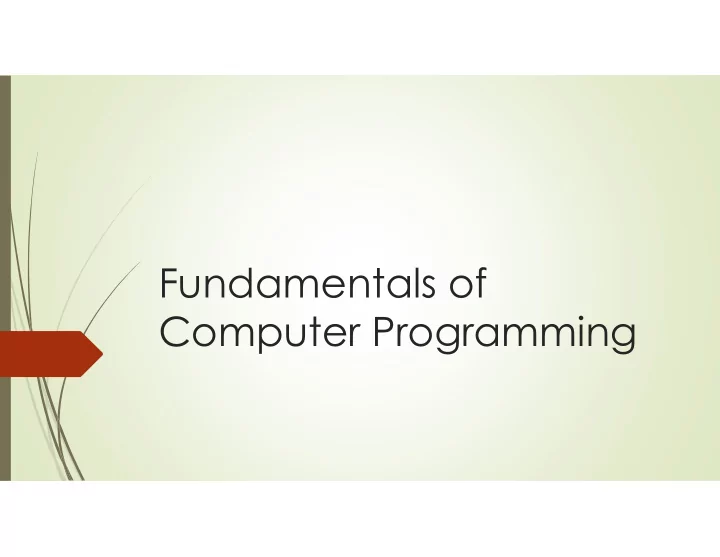

Fundamentals of Computer Programming
How class is conducted Learn basic programming concepts Learn Python programming language Learn problem-solving skills Lab sessions (Monday sessions) Lecture sessions (Friday sessions)
Resources Textbooks A. Downey, “Think Python.” 2012. O’Reilly. url: http://greenteapress.com/wp/think-python/ Online resources https://www.python.org/doc/
Introduction A modern computer: “a machine that stores and manipulates information under the control of a changeable program .” Computer program: A detailed step-by-step set of instructions telling a computer what to do.
Introduction Computer, The Universal Machine With a suitable programming, any computer can do tasks any other computer can do. Program is called software Computer (Machine) is called hardware Hardware operates under the control of a software
Introduction Learn programming Develop problem-solving skills Analyze a problem Simplify it to interaction among simpler tasks Refine them to available resources, i.e., instructions Algorithms a step-by-step process to achieve the desired results
Introduction Hardware (Von Neumann Machine)
Von Neumann Machine Central Processing Unit (CPU) carries out all the computations calculate arithmetic evaluate logic manage a flow of information CPUs manipulate information Programs control CPU A program is also an information! Great Idea! Information controls hardware to control information.
Von Neumann Machine Memory stores information Information: programs and data Another paradox? CPU uses memory. CPU is controlled by programs. Programs are stored in memory. So, who controls who? No. it’s not like who is the supreme leader. It’s more like working together. Peace and harmony at last.
Von Neumann Machine Memory CPU can only directly access information stored in main memory (RAM or Random Access Memory). Main memory is fast, but volatile, i.e. when the power is interrupted, the contents of memory are lost.
Von Neumann Machine Memory Secondary memory provides more permanent storage: magnetic (hard drive), flash (SSD, USB memory), optical (CD, DVD) CPU accesses secondary memory through main memory. “Memory hierarchy.”
Von Neumann Machine Input Information is passed to the computer through keyboards, mice, etc. Output Processed information is presented to the user through the monitor, loudspeaker, printer, etc.
Von Neumann Machine Fetch-Execute Cycle CPU retrieves an instruction from memory CPU decodes the instruction to see what it means CPU carries out the action Next instruction gets fetched, decoded, executed. … fetch, decode, execute, repeat, …
Programs/Programming Languages Program (in computer memory) machine code specific to hardware inhumane to read E.g., 0x0A0911FE Program (We will write) more humanize print(“Hello”)
Programs/Programming Languages Program (We will write) more humanize print(“Hello”) not (or at least less) specific to hardware So, we write (humanized) programs. Computer reads (inhumane) programs. Our programs get translated to computer program by a translator. Our program is often called a program. Computer program is often called machine code.
Programs/Programming Languages Translator a program to translate another program written in programming language to machine code Machine code: specific to machine Program: specific to programming language
Programming Languages Natural language has ambiguity and imprecision not suitable to describe complex algorithms. Programs are written in programming languages Every structure in programming language has a precise form, called syntax Every structure has a precise meaning, called semantics
Translator: Compiler v.s. Interpreter Translation: Program --> Machine code Compiler translates a program to machine code Interpreter simulates a computer that understands a high-level language the source program is not translated into machine code all at once An interpreter analyses and executes the source code instruction by instruction
Compiler
Interpreter
Compiler v.s. Interpreter Compiler Once program is compiled, it can be executed over and over without the source code or compiler. Interpreter The source code and interpreter are needed each time the program runs
Compiler v.s. Interpreter Compiled programs generally run faster since the translation of the source code happens only once. Interpreted languages are part of a more flexible programming environment since they can be developed and run interactively. Interpreted programs are more portable , meaning the executable code produced from a compiler for a Pentium won’t run on a Mac, without recompiling. If a suitable interpreter already exists, the interpreted code can be run with no modifications.
Python “Python is an interpreted, interactive, object-oriented programming language. … Python is portable: it runs on many Unix variants, on the Mac, and on Windows 2000 and later.” – python.org Why do we learn Python? “Python is a powerful, flexible, open source language that is easy to learn, easy to use, and has powerful libraries for data manipulation and analysis. … Python has a unique combination of being both a capable general-purpose programming language as well as being easy to use for analytical and quantitative computing.” -- https://www.continuum.io/why-python
Glimpse of Python print("Hello") x = 8 print("x") print(x) Each command is called a statement print(…) is a command to invoke a built-in function print what in the parentheses are function’s arguments. "Hello" is an argument of print("Hello") "x" is an argument of print("x") x is an argument of print(x)
Glimpse of Python print("Hello") x = 8 print("x") print(x) print function help(print) built-in functions help(__builtins__) type <q> to quit or better, see https://docs.python.org/3/library/functions.html
Glimpse of Python print("Hello") x = 8 print("x") print(x) x = 8 x is an example of a variable A variable is used to assign a name to a value so that we can refer to it later. x = 8 is an assignment statement Variable is assigned a value of 8 (the right-hand side of the " = ")
Milestones Introduction First program in python Basic console output/input & variables Selection / flowchart Functions Loops Collection variables Files Advanced topics
For a curious mind A program in Python is compiled into a bytecode, then executed by the interpreter in a similar manner to Java. What are advantages of bytecode over native code? “Hank Shiffman from SGI said: There are three advantages of Java using byte code instead of going to the native code of the system … Portability , Security , Size …” src: https://stackoverflow.com/questions/48144/what-are-advantages- of-bytecode-over-native-code
Recommend
More recommend